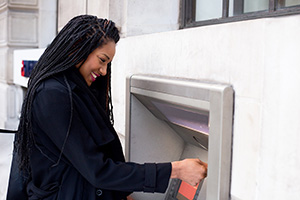
How blockchain technology is changing treasury

Blockchain: Separating hype from substance

Commercial real estate in 2020: Keeping up with the pace of change

Hybridization driving demand

The AI journey in finance: How to make it part of your strategy

Supply chain analysis: Merging technology and commerce

The ongoing evolution of custody

3 emerging technology trends for bankers

The startup scene in Reno: The story of Breadware

The startup scene in Reno: Emerging tech leads the way

Refinancing your practice loans: What to know

What type of loan is right for your business?

Finance or operating lease? Deciphering the legalese of equipment finance

Common pitfalls to avoid in the equipment financing process

Buying or leasing? Questions to ask before signing a contract

ABL mythbusters: The truth about asset-based lending

Easier onboarding: What to look for in an administrator

Luxembourg's thriving private debt market

3 questions to ask your equity, quant and CTA fund administrator

How to choose the right custodian for your managed assets

Private equity and the full-service administrator

The secret to successful service provider integration

Insource or outsource? 10 considerations

10 ways a global custodian can support your growth

The benefits of a full-service warehouse custodian

Webinar: Cash management strategies for higher education

Solutions banks can offer during the COVID-19 pandemic

Colleges respond to student needs by offering digital payments

Integrated receivables management solution supports customer focus at MSC Industrial Supply

Webinar: Robotic process automation
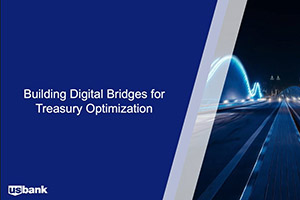
Webinar: Building digital bridges for treasury optimization

Authenticating cardholder data reduce e-commerce fraud

Webinar: CRE technology trends
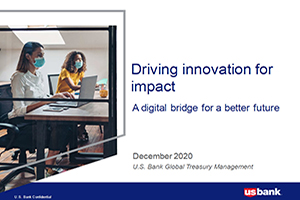
Webinar: Driving innovation to impact treasury management

Webinar: CRE treasury leader roundtable
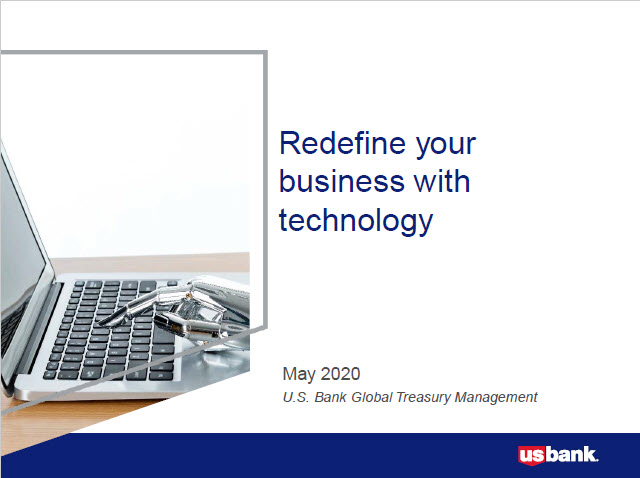
Webinar: Redefine your business with technology
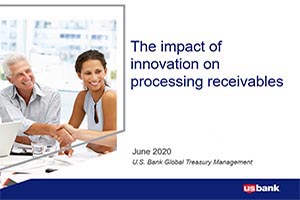
Webinar: The impact of innovation on processing receivables

The cyber insurance question: Additional protection beyond prevention

Drive digital transformation with payments innovation

Beyond the back office: real-time payments

Leading the way for real-time payments

Real-time payments fuel innovation

Real-time answers about real-time payments

Looking like a million bucks: The business case for high-value real-time payment

Role of complementary new channels in your payments strategy

How electronic billing platforms improve government payments

What government officials should know about real-time payments

ABCs of APIs: Drive treasury efficiency with real-time connectivity

How emerging banking solutions enable better decisions

Want AP automation to pay both businesses and consumers?

Time is money: Intelligent Payment Routing saves businesses both

Digital trends poised to reshape hotel payments

Digital banking for business: How connectivity improves customer experience

Banking connectivity: Helping businesses deliver the easier, faster, more secure customer experience of the future

Enhancing the patient experience through people-centered payments

Tech tools to keep your restaurant operations running smoothly

Unexpected cost savings may be hiding in your payment strategy

Automate escheatment for accounts payable to save time and money

ePOS cash register training tips and tricks

Cashless business pros and cons: Should you make the switch?

Automate accounts payable to optimize revenue and payments

A simple guide to set up your online ordering restaurant

What to know when investing in AP automation solutions

The benefits of payment digitization: Pushing for simplicity

Collect utility and telecom bill payments faster

5 winning strategies for managing liquidity in volatile times

Higher education and the cashless society: Latest trends

Zelle® helps Sunriver Resort make payments efficient and secure

3 ways to make practical use of real-time payments

Buried treasure: Maximizing analytics for treasury management

How AI in treasury management is transforming finance

The future of financial leadership: More strategy, fewer spreadsheets

Instant Payments: Accelerating treasury disruption

Can faster payments mean better payments?

Empowering managers with data automation and integration

4 ways Request for Payments (RfP) changes consumer bill pay

Protecting cash balances with sweep vehicles

Delivering powerful results with SWIFT messaging and services

Digital Onboarding helps finance firm’s clients build communities

New technology streamlines M&A transactions

Why retail merchandise returns will be a differentiator in 2022

How RIAs can embrace technology to enhance personal touch

Innovative payroll solutions may help attract hourly workers

Flexibility remains essential for public sector workforces

Tailor Ridge eBill case study

What corporate treasurers need to know about Virtual Account Management

CFO survey: A shifting focus on ESG in business

Digital receivables to meet changing demand

CFO report: Driving growth via new business models and technology

Treasury management innovations earn Model Bank awards

CFO insights: Leading the recovery for sustainable growth

Staying organized when taking payments

Tools that can streamline staffing and employee management

Key considerations for online ordering systems

How iPads can help increase efficiency in your salon

How does an electronic point of sale help your business keep track of every dime?

Planning for restaurant startup costs and when to expect them

Make your business legit

How to identify what technology is needed for your small business

How to fund your business without using 401(k) savings

The different types of startup financing

How to redefine challenges with business collaboration

How small businesses are growing sales with online ordering

How business owners are managing during the supply chain crisis

Why ecommerce for small business strategy is integral

6 common financial mistakes made by dentists (and how to avoid them)

Common small business banking questions, answered

3 signs it’s time for your business to switch banks

Unexpected expenses: 5 small business costs to know and how to finance them

Business credit card 101

How to apply for a business credit card

Technology strategies to complement your business plan

Meet your business credit card support team

How Everyday Funding can improve cash flow

How a small business is moving forward during COVID-19

How jumbo loans can help home buyers and your builder business

8 Ways for small business owners to manage their cash flow

Does your side business need a separate bank account?

Break free from cash flow management constraints

How to make the most of your business loan

Leverage credit wisely to plug business cash flow gaps

5 tips for managing your business cash flow

How running a business that aligns with core values is paying off

Meet the Milwaukee businessman behind Funky Fresh Spring Rolls

3 ways to gain loyalty with your customers

What types of agency accounts are available for investors?

What you need to know as the executor of an estate

Recognize. React. Report. Caregivers can help protect against financial exploitation

Recognize. React. Report. Don't fall victim to financial exploitation

Is online banking safe?

8 tips and tricks for creating and remembering your PIN

Does your savings plan match your lifestyle?

Adulting 101: How to make a budget plan

Which is better: Combining bank accounts before marriage — or after?

Personal finance for teens can empower your child

Don’t underestimate the importance of balancing your checking account

Is it time to get a shared bank account with your partner?

Here’s how to create a budget for yourself

Multiple accounts can make it easier to follow a monthly budget

Checking and savings smarts: Make your accounts work harder for you

5 reasons why couples may have separate bank accounts

Dear Money Mentor: How do I set and track financial goals?

5 tips for parents opening a bank account for kids

Myths vs. facts about savings account interest rates

30-day adulting challenge: Financial wellness tasks to complete in a month

First-timer’s guide to savings account alternatives

How voice-activated devices work with banks

P2P payments make it easier to split the tab
